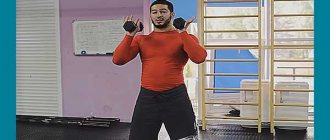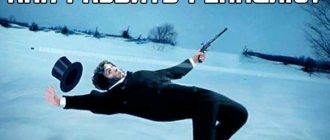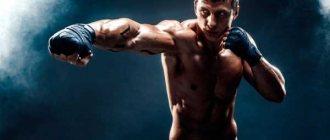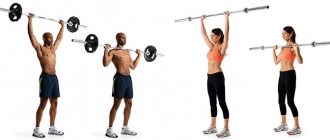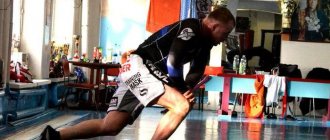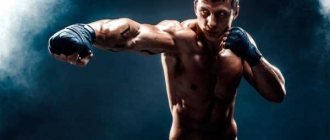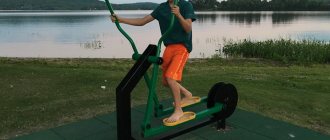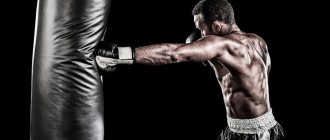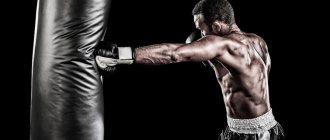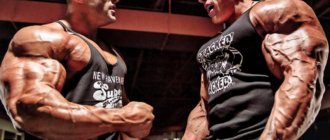The level of skill of an athlete depends on a set of innate and acquired skills that are improved during the training process. For mixed martial arts fighters, achieving high results is influenced not only by technical-tactical, physical and psychological preparation, but also by the degree of development of specific reflexes and states of the body, determined by its individual psychophysiological characteristics - speed of motor reaction, coordination, stress resistance, fatigue, pain threshold sensitivity.
The importance of reaction speed for MMA fighters
The structure of the reaction mechanism includes the time interval from the beginning of the enemy’s unexpected movement to its own counter-action and is divided into three periods:
- Perception of the stimulus (preliminary period);
- Signal processing (latent period);
- Feedback (execution period).
There are simple and complex types of reaction to an external stimulus. A simple reaction is typical for responding to a predicted movement - for example, a fighter expects a low kick and prepares to block it. A complex reaction is the reaction of choice when it is necessary to quickly navigate an unforeseen situation - for example, when the enemy carries out an attacking combination with elements of deliberately false attacks.
MMA fights are rich in a variety of techniques, so a timely and adequate response to the enemy’s actions is one of the determining factors for success in a confrontation. It is not always possible to “calculate” the opponent’s intentions in advance, and then impromptu answers that are based on the speed of reaction come to the rescue.
As the fight progresses, such situations arise for attacking, counterattacking and defensive actions, and therefore, the response is most often of a complex type, characteristic of a choice reaction.
The training methodology for MMA fighters provides for special training aimed at improving the speed of motor reaction and the ability to differentiate a task.
How to train reaction in boxing classes?
Typically, in boxing sections, athletes are taught technical skills at the beginning. At the same time, it is good when theoretical classes (work in front of the mirror, boxing school in step) are firmly connected with working out in pairs. Naturally, it is quite stupid to pair newcomers for free work - it will generally resemble just a fight, especially since both athletes will be exhausted. Of course, there is no benefit from such a training process.
The correct direction of training activity would be in which the beginner is first taught the basics, his general physical fitness is shown and strengthened, and only then (after about 4-6 weeks from the start of training) he is paired with a partner.
An experienced trainer does not put emphasis on “fun” and “interesting” training. Real effective boxing training (including reaction training) takes place with constant repetitions and drills in order to bring these defense and attack movements to automaticity.
Reaction exercises
A set of specialized exercises that are used in training to increase the speed of motor reactions is focused on repeated repetition of movements, with a gradual transition from simple to complex tasks. For athletes involved in martial arts, the main stimulus is the visual signal, so attention is paid to developing the ability to quickly respond to a visual stimulus (sensorimotor reaction).
Exercises with a tennis ball
- Throwing the ball at the wall and catching it, alternately, with the left and right hand, varying the force of the throw.
- Catching the ball from a partner - standing with your back, at the signal, turn around and catch the ball.
- Deflections from a ball thrown to the head by a partner (the speed of the throw and the distance between partners vary).
- Hitting the ball to the floor with different rebound forces and catching it, on the spot and while moving from a fighting stance.
Reaction ball exercises
The “trick” of the ball is the unpredictability of its rebound. Options for catching it from a standstill and on the move are being worked out.
Exercises with a pendulum bag
A small bag of sand (up to 300 g) is attached to the ceiling (crossbar) and swings.
- Pushing the bag forward and practicing slopes to the left/right of the returning projectile.
- A dodge while simultaneously simulating a counterattack with a single strike.
- Dodge with a counterattack from a series of blows.
Impact speed development
Impact speed is an important indicator and is directly dependent on reaction speed. The faster the blow is delivered, the more force it will have. The most effective boxing movements are rightfully considered to be actions aimed at a quick attack or counterattack.
When performing a good punch, the boxer's hand constantly accelerates, and the momentum is transferred to the opponent upon impact. In order to develop the speed of impact, it is recommended to practice movements in the mode of increased power load. The use of dumbbells, weights and expanders is encouraged. Performing various exercises under increased tension will allow you to develop a high speed of impact, since there is no tension in the ring, making it easier to make sudden movements.
Working with weights requires a competent approach. For example, you need to start exercises with minimal weight. Over time it is gradually increased. In order to avoid unwanted overwork, it is recommended to work with weights according to a specific schedule, which is selected by the trainer individually.
Not only dumbbells and weights, but also belts, cuffs, and vests are often used as weights. Thanks to them, you can not only choose the right load, but also easily adjust it in any direction.
To develop impact speed, it is recommended to use weights of various weights. It is necessary to alternately work with light and heavy weights. The training should end with practicing strikes without weights.
Exercises with the Fight Ball simulator
- Practicing single and serial strikes of different strengths and trajectories, without letting the ball touch your face.
- Return to a fighting stance after each blow or series.
- Perform step 2 while moving.
- Performing step 3 without looking at the ball (the gaze is focused on a third-party object) - training the reaction of peripheral vision.
"A fight with a shadow"
Imitation of various attacking and defensive actions, with changes in intensity and speed.
Exercises in pairs and sparring
Practicing the speed of response to intentional (pre-determined) and unexpected actions of a partner.
Methodological recommendations also include playing team sports (table tennis, football, basketball) and finger games (odd-even, rock-paper-scissors, crackers).
Practice shows that training complex movements, the ability to optimally manage muscle tension, and improving technical and tactical training help increase the speed characteristics of a motor reaction.
What is football?
As stated above, a fight ball is a ball that is tied to a bandage with an elastic band. Balls are made from various components, which allows you to choose exactly what will be perfect for you!
The bandage is put on the head (more precisely on the forehead) of the athlete. Adjusting the length of the elastic is easy! The ideal length to start practicing punches will be from the forehead to the navel (the shorter the length of the band, the more difficult). It is also better to start with light blows, because it will not be particularly pleasant to get hit in the eye by yourself.
Many people call the main advantage of this simulator its compactness. You can easily put it in your pocket and go for a workout in the gym, on the street, or in nature!
No. 7. Working on the block
This type of training helps develop the correct choice of block placement. This exercise is performed with a helmet and an experienced partner. As a rule, such training takes place in the training ring, or en masse in the empty space of the boxing gym.
When performing an exercise, 2 fighters stand opposite each other and perform the exercises in shifts. One plays as an attacker, and attacks in every possible way, and the other plays as a blocker, and fights off everything he can.
Picture 1. Block training in boxing
No. 3. Training on a small bag
Training on a small bag can be aimed not only at developing the speed and sharpness of the blow. Since the punching bag bounces back very quickly, many experienced boxers use it as a punch to their opponent, do 1-2 dodges, and then strike again. And so on in a circle. The exercise trains the boxer's deflection, as well as seeing the opponent's punches.
Picture 3. Working with a small pear
Boxing School: Thinking Training
Templates do little to exercise the brain. That is, following templates kills your potential over and over again.
Boxing is not only physical reactions, but also thinking, the ability to find quickly effective solutions in the ring.
Imagine that you came to the gym, the trainer put you in a stance. You have begun to learn the first movements. But every time you feel stiffness in your muscles, the clamps prevent you from hitting in a relaxed manner. And the “correct” stance, which the coach showed, strengthens you even more. The training continues. You are already working in the ring, but the clamps constrain your body, which is why you do not have time to react to the enemy’s attacks and strike back. But then you work in an academic stance, and only such a stance can be considered the only correct one in a single boxing gym.
IMMEDIACY
The thing is that a training program built on templates deprives you of the opportunity to develop your own movements, of course, within the framework of boxing. The movements that your body and your thinking generate. Only you can understand how to control your body most effectively.
As food for thought: take a look at African-American champions - how unusually they move, at what angles they strike, what defensive actions they resort to. Their movements are unique, their thinking is creative, not clogged with unnecessary templates and rules, and their body is free of clamps. Let's just say: in the ring they are as spontaneous as children.
Until a certain moment, children do not think about how they look in the eyes of others. All their movements have this important quality - ease. It seems to me that adults are destroying this property brick by brick.
One father took up the physical training of his hockey-playing son. The child performed simple running and jumping exercises. The father, instead of giving the ten-year-old boy freedom for creativity, freedom of movement, constantly shouted at him and corrected the technique of the exercise. “Stand up straight”, “you’re not moving like that”, “you can’t jump faster” - these remarks sounded like thunder. A month later, I noticed that the boy began to move like a robot, stiff and very constrained. But the worst thing was that after every exercise he looked at his father. I was looking for approval. If only the father could skate on the ice instead of his son, demonstrating his style of hockey.
Coaching instead of competent teaching leads to a dead end.
WHAT TO DO THEN?
Train your thinking. It is what determines how you move, how quickly you react in the ring, how much control you have over your body. In order to liberate the body and mind, there are game training methods. For example, a student who is afraid to take a blow (fear of missing a blow) should change the learning conditions. While he is afraid of a blow, the boxer does not learn either defensive or attacking actions. He lacks confidence: “My defensive skills are so perfect that I’m ready to take on a real fight.”
In this situation, of course, playful boxing exercises that exclude strong blows will allow you to develop the necessary defensive skills and coordination. And only after, when the boxer gains confidence and gets rid of psychological barriers, it will be possible to increase the pace, the power of the blow and move on to combat practice. The most important thing is that game exercises train lateral thinking in the ring and help remove clamps.
GAME BOXING EXERCISES
As illustrations, I provide two videos. The first exercise is for three participants:
- Boxers stand in a triangle position and throw jabs with their right and left hands to each other. Strikes without force are actually touches with the striking part of the glove.
- Every man for himself.
- Boxers learn to react quickly to attacks and rapidly changing situations: I attack from two sides, I have to be constantly on the alert.
In the following video, the student practices the movements while wearing a blindfold. The coach sets the direction of attacks with his voice and touch. The student's task is to hit the paws and move in space. At this moment, the brain works completely differently. We eliminated vision from the process - broke the mold and made our computer work with a vengeance. This is a real brain workout.
Many boxers come up with whole sets of similar exercises quite by accident. For example, some people box at dusk in the forest. Under such conditions, all instincts are heightened and muscle sense (touch) is activated. And accordingly, new fighting qualities are developed. And for the brain, such a shake-up is a magical kick for generating new movements, combinations and maneuvers.
No. 6. Working with the ball
For those who love active defense and don’t like to miss at all, exercises with the ball, or rather with a ball, are perfect. If you look at many professionals, you can often see such a sight. The boxer stands against the wall in a standing position, and small balls are thrown at him. The whole point of the exercise is to avoid and block as effectively as possible, using only a boxing stance, and without lowering your arms.
This exercise effectively develops automaticity, as well as the feeling and accuracy of movements. Great for developing reflexive defensive skills.
No. 2. Individual training with a trainer.
This is a type of training where the boxer throws several punches against pads. After which the coach carries out counter attacks. The boxer himself must avoid them. This exercise perfectly helps not only to deliver a blow, but also not to forget about defense during the fight. Individual training constitutes the boxer’s base from which he will enter the ring.
Picture 4. Individual training
